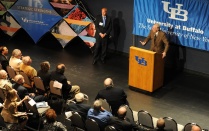UB researchers to study why stocked fish are not reproducing in Lake Ontario
By Peter Murphy
Release Date: March 7, 2022
BUFFALO, N.Y. – A University at Buffalo research team will investigate why stocked fish in Lake Ontario are not reproducing.
The effort is being funded by New York Sea Grant, which recently announced eight projects totaling $1.3 million.
“Our question is motivated by fish survival, longevity and sustainability in Lake Ontario,” says principal investigator Joseph F. Atkinson, PhD, director of UB’s Great Lakes Program and an expert in water quality modeling and sediment transport. “The [New York State Department of Environmental Conservation] NYSDEC stocks fish every year. Why aren’t they reproducing?”
The NYSDEC stocks fish to support the Lake Ontario food web and the eco-tourism industry, but the stocked fish do not reproduce.
In addition to Atkinson, who is professor and chair of the Department of Civil, Structural and Environmental Engineering, the team includes Zhenduo Zhu, PhD, assistant professor of environmental engineering, and Trevor Krabbenhoft, assistant professor in the Department of Biological Sciences in the UB College of Arts and Sciences. Krabbenhoft is also a member of the UB RENEW Institute.
The UB researchers, as well as researchers at the United States Geological Survey, suspect climate change is affecting the fish population.
“There is increased erosion and stronger fluctuations in water levels because of climate change. The Great Lakes have had the highest and lowest water levels in recorded history within the last 10 years,” Atkinson says. “This erosion affects sedimentation and the hypothesis we’re investigating is whether sedimentation is covering areas where fish would traditionally spawn.”
Fish generally spawn in gravel or sandy areas where their eggs can be secure and have access to aerated water during incubation. Under normal conditions, fish would hatch later in the year, but researchers think there could be a fine layer of sediment covering areas where fish traditionally spawn, preventing the eggs from getting the oxygen they need.
“Once we identify whether or not that is the problem, then we can look at some potential remedies for that problem: Are there structures we could put in near-shore areas that could help improving spawning habitats?” Atkinson says.
Researchers will take samples, measure the sedimentation rates, and utilize hydrodynamic and coastal erosion modeling to better characterize select spawning sites and understand sedimentation processes there. They will use the data to verify the output of the models and explore ways to manage sedimentation to provide fish with a space for successful incubation of the eggs.
“We are going to test and measure samples from three specific regions along the New York shoreline of Lake Ontario: east of the Niagara River, near Oswego and Chaumont Bay,” Atkinson says. “We are hoping our work will contribute to rebuilding sustainability for the Lake Ontario fishery.”
Media Contact Information
Media Relations (University Communications)
330 Crofts Hall (North Campus)
Buffalo, NY 14260-7015
Tel: 716-645-6969
ub-news@buffalo.edu


